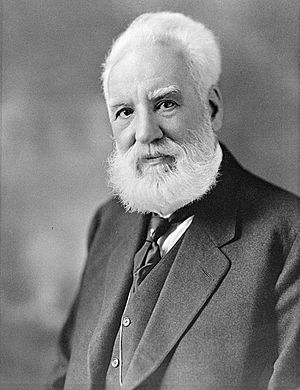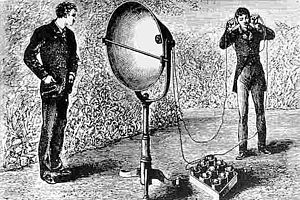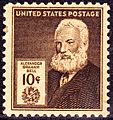Alexander Graham Bell facts for kids
Quick facts for kids
Alexander Graham Bell
|
|
|---|---|

Bell c. 1917
|
|
| Born | March 3, 1847 |
| Died | August 2, 1922 (aged 75) Beinn Bhreagh, Nova Scotia, Canada
|
| Citizenship | United Kingdom (1847–1922) British-subject in Canada (1870–1882) United States (1882–1922) |
| Alma mater | |
| Occupation |
|
| Known for | Invention of the telephone b |
| Spouse(s) |
Mabel Hubbard
(m. 1877) |
| Children | Four c |
| Parent(s) |
|
| Relatives |
|
| Awards |
|
| Signature | |
| Notes | |
|
|
Alexander Graham Bell (March 3, 1847 - August 2, 1922) was a teacher, scientist, inventor, and entrepreneur. He was the founder of the Bell Telephone Company.
Contents
Early life and family
Alexander Graham Bell was born in Edinburgh, Scotland. He had two brothers: Melville James Bell (1845–1870) and Edward Charles Bell (1848–1867), both of whom died of tuberculosis. His father was Alexander Melville Bell, a phonetician, and his mother was Eliza Grace Bell (née Symonds). Born as just "Alexander Bell", at age 10 he made a plea to his father to have a middle name like his two brothers. For his 11th birthday, his father allowed him to adopt the name "Graham", chosen out of respect for Alexander Graham, a Canadian being treated by his father who had become a family friend. To close relatives and friends he remained "Aleck". Bell and his siblings attended a Presbyterian Church in their youth.
His family was known for teaching people how to speak English clearly (elocution). Both his grandfather, Alexander Bell, and his father, Alexander Melville Bell, taught elocution. His father often wrote about this and is most known for his invention and writings of Visible Speech. In his writings, he explained ways of teaching people who were deaf and mute (unable to speak). It also showed how these people could learn to speak words by watching their lips and reading what other people were saying.
Bell's father taught him and his brothers not only to write Visible Speech but to identify any symbol and its accompanying sound. Bell became so proficient that he became a part of his father's public demonstrations and astounded audiences with his abilities. He could decipher Visible Speech representing virtually every language, including Latin, Scottish Gaelic, and even Sanskrit, accurately reciting written tracts without any prior knowledge of their pronunciation.
From his early years, Bell showed a sensitive nature and a talent for art, poetry, and music that was encouraged by his mother. With no formal training, he mastered the piano and became the family's pianist. Despite being normally quiet and introspective, he revelled in mimicry and "voice tricks" and continually entertained family guests during their occasional visits. Bell was also deeply affected by his mother's gradual deafness (she began to lose her hearing when he was 12), and learned a manual finger language so he could sit at her side and tap out silently the conversations swirling around the family parlour. He also developed a technique of speaking in clear, modulated tones directly into his mother's forehead wherein she would hear him with reasonable clarity. Bell's preoccupation with his mother's deafness led him to study acoustics.
First invention
As a child, Bell displayed a curiosity about his world; he gathered botanical specimens and ran experiments at an early age. His best friend was Ben Herdman, a neighbour whose family operated a flour mill. At the age of 12, Bell built a homemade device that combined rotating paddles with sets of nail brushes, creating a simple dehusking machine that was put into operation at the mill and used steadily for a number of years. In return, Ben's father John Herdman gave both boys the run of a small workshop in which to "invent".
Education
As a young child, Bell, like his brothers, was schooled at home by his father. At an early age, he was enrolled at the Royal High School, Edinburgh; he left at age 15, having completed only the first four forms. His school record was undistinguished, marked by absenteeism and lackluster grades. His main interest remained in the sciences, especially biology, while he treated other school subjects with indifference, to his father's dismay. Upon leaving school, Bell traveled to London to live with his grandfather, Alexander Bell, on Harrington Square. During the year he spent with his grandfather, a love of learning was born, with long hours spent in serious discussion and study. The elder Bell took great efforts to have his young pupil learn to speak clearly and with conviction, attributes he would need to become a teacher himself. At age 16, Bell secured a position as a "pupil-teacher" of elocution and music at Weston House Academy in Elgin, Moray, Scotland. Although enrolled as a student in Latin and Greek, he instructed classes himself in return for board and £10 per session. The next year, he attended the University of Edinburgh, joining his brother Melville, who had enrolled there the previous year. In 1868, not long before he departed for Canada with his family, Bell completed his matriculation exams and was accepted for admission to University College London.
First experiments with sound
His father encouraged Bell's interest in speech and, in 1863, took his sons to see a unique automaton developed by Sir Charles Wheatstone based on the earlier work of Baron Wolfgang von Kempelen. The rudimentary "mechanical man" simulated a human voice. Bell was fascinated by the machine and after he obtained a copy of von Kempelen's book, published in German, and had laboriously translated it, he and his older brother Melville built their own automaton head. Their father, highly interested in their project, offered to pay for any supplies and spurred the boys on with the enticement of a "big prize" if they were successful. While his brother constructed the throat and larynx, Bell tackled the more difficult task of recreating a realistic skull. His efforts resulted in a remarkably lifelike head that could "speak", albeit only a few words. The boys would carefully adjust the "lips" and when a bellows forced air through the windpipe, a very recognizable Mama ensued, to the delight of neighbours who came to see the Bell invention.
Intrigued by the results of the automaton, Bell continued to experiment with a live subject, the family's Skye Terrier, Trouve. After he taught it to growl continuously, Bell would reach into its mouth and manipulate the dog's lips and vocal cords to produce a crude-sounding "Ow ah oo ga ma ma". With little convincing, visitors believed his dog could articulate "How are you, grandmama?" Indicative of his playful nature, his experiments convinced onlookers that they saw a "talking dog".
Move to Canada
In 1870, when he was 23 years old, he moved with his family to Canada where they settled at Brantford, Ontario. Bell began to study communication machines. He made a piano that could be heard far away by using electricity. In 1871, he went with his father to Montreal, Quebec, in Canada, where he took a job teaching about "visible speech." His father was asked to teach about it at a large school for deaf mutes in Boston, Massachusetts, but instead he gave the job to his son. The younger Bell began teaching there in 1872. Alexander Graham Bell soon became famous in the United States for this important work. He published many writings about it in Washington, D.C.. Because of this work, thousands of deaf mutes in the United States of America can now speak, even though they cannot hear.
In 1876, Bell was the first inventor to patent the telephone, and he helped start the Bell Telephone Company with others in July 1877. In 1879, this company joined with the New England Telephone Company to form the National Bell Telephone Company. In 1880, they formed the American Bell Telephone Company, and in 1885, American Telephone and Telegraph Company (AT&T), still a large company today. Along with Thomas Edison, Bell formed the Oriental Telephone Company on January 25, 1881.
Inventions
Bell had eighteen patents granted in his name alone. He shared twelve patents with others. These included fifteen for the telephone and telegraph, four for the photophone, one for the phonograph, five for aeronautics, four for hydrofoils, and two for a selenium cell.
Telephone
In 1874, Bell began working with a musical telegraph, in which he used an electric circuit and a magnet to make an iron reed or tongue vibrate. One day, it was found that a reed failed to respond to the current. Mr. Bell asked his assistant, who was at the other end of the line, to pluck the reed, thinking it had stuck to the magnet. His assistant, Thomas Watson did so. To Bell's, surprise, he heard the corresponding reed at his end of the line vibrate and sound the same - without any electric current to power it. A few experiments soon showed that his reed had been set in vibration by the changes in the magnetic field that the moving reed produced in the line. This discovery led him to stop using the electric battery current. His idea was that, since the circuit was never broken, all the complex vibrations of speech might be converted into currents, which in turn would reproduce the speech at a distance.
Bell, with his assistant, designed a receiver, consisting of a stretched film or drum with a bit of magnetized iron attached to its middle, and free to vibrate in front of the pole of an electromagnet in a circuit with the line. This device was completed on June 2, 1875. On July 7, he instructed his assistant to make a second receiver that could be used with the first, and a few days later they were tried together, at each end of the line, which ran from a room in the inventor's house at Boston to the cellar underneath. Bell, in the room, held one device in his hands, while Watson in the cellar listened at the other. The inventor spoke into his instrument, "Do you understand what I say?" and Mr. Watson rushed back upstairs and answered "Yes." The first successful two-way telephone call was not made until March 10, 1876, when Bell spoke into his device, "Mr. Watson, come here, I want to see you," and Watson answered back and came into the room to see Bell. The first long-distance telephone call was made on August 10, 1876, by Bell from the family home in Brantford, Ontario, to his assistant in Paris, Ontario, about 10 miles (16 km) away.
On March 7, 1876, the U.S. Patent Office gave him patent #174465 for the telephone.
Photophone
Bell and his assistant Charles Sumner Tainter jointly invented a wireless telephone, named a photophone, which allowed for the transmission of both sounds and normal human conversations on a beam of light. Both men later became full associates in the Volta Laboratory Association.
On June 21, 1880, Bell's assistant transmitted a wireless voice telephone message a considerable distance, from the roof of the Franklin School in Washington, D.C., to Bell at the window of his laboratory, some 700 feet (213 m) away, 19 years before the first voice radio transmissions.
Bell believed the photophone's principles were his life's "greatest achievement", telling a reporter shortly before his death that the photophone was "the greatest invention [I have] ever made, greater than the telephone". The photophone was a precursor to the fiber-optic communication systems which achieved popular worldwide usage in the 1980s. Its master patent was issued in December 1880, many decades before the photophone's principles came into popular use.
Metal detector
Bell is also credited with the invention of an improved metal detector in 1881 that made sounds when it was near metal. The device was quickly put together in an attempt to find the bullet in the body of U.S. President James Garfield. The metal detector worked but did not find the bullet because of the metal bedframe the President was lying on. Bell gave a full description of his experiments in a paper read before the "American Association for the Advancement of Science" in August 1882.
Opinions
Bell was an active supporter of the eugenics movement in the United States. He was the honorary president of the "Second International Congress of Eugenics" held at the American Museum of Natural History in New York in 1921.
As a teacher of the deaf, Bell did not want deaf people to teach in schools for the deaf. He was also against the use of sign language. These things mean that he is not appreciated by some deaf people in the present day.
Personal life and death
Bell married Mabel Hubbard on July 11, 1877. The couple had four children:
- Elsie May Bell (1878–1964).
- Marian Hubbard Bell (1880–1962) who was referred to as "Daisy".
- Two sons who died in infancy (Edward in 1881 and Robert in 1883).
Bell died of diabetes at his home near Baddeck, Nova Scotia, in 1922.
Honors
- In 1888, he was one of the original members of the National Geographic Society and became its second president.
- The French government gave him the decoration of the Legion of Honor.
- The Royal Society of Arts in London awarded him the Albert medal in 1902.
- The University of Würzburg, Bavaria, granted him the Degree of Ph.D.
Alexander Graham Bell quotes
- "Concentrate all your thoughts upon the work at hand. The sun's rays do not burn until brought to a focus."
- "Before anything else, preparation is the key to success."
- "A man, as a general rule, owes very little to what he is born with - a man is what he makes of himself."
- “The inventor...looks upon the world and is not contented with things as they are. He wants to improve whatever he sees, he wants to benefit the world; an idea haunts him.”
Interesting Facts about Alexander Graham Bell
- Alexander Graham Bell’s mother and wife were deaf.
- Alexander received a middle name for his eleventh birthday. He asked his father to give him one because his brothers had one.
- Alexander considered the photophone greater than the telephone.
- Because he found the telephone distracting and intrusive, he did not like to have one in his study.
- Bell's home used a primitive form of air conditioning, in which fans blew currents of air across great blocks of ice.
- Alexander directed Helen Keller’s father to Perkins School for the Blind, where he met and hired Anne Sullivan.
- Bell helped establish the National Geographic Society.
- Bell helped guide the first controlled plane in Canada, the Silver Dart.
- Bell invented the world’s fastest speedboat in 1919. The boat set a speed record of 70.86 miles per hour.
Images for kids
-
Melville House, the Bells' first home in North America, now a National Historic Site of Canada
-
Bell, top right, providing pedagogical instruction to teachers at the Boston School for Deaf Mutes, 1871. Throughout his life, he referred to himself as "a teacher of the deaf".
-
An actor playing Bell in a 1926 film holds Bell's first telephone transmitter
-
Bell statue by A. E. Cleeve Horne in front of the Bell Telephone Building of Brantford, Ontario, The Telephone City. (Brantford Heritage Inventory, City of Brantford)
-
A quote by Alexander Graham Bell engraved in the stone wall within the Peace Chapel of the International Peace Garden (in Manitoba Canada and North Dakota, USA).
-
Bell, an alumnus of the University of Edinburgh, Scotland, receiving an honorary Doctor of Laws degree (LL.D.) at the university in 1906
See also
 In Spanish: Alexander Graham Bell para niños
In Spanish: Alexander Graham Bell para niños

















